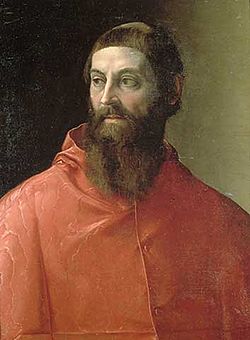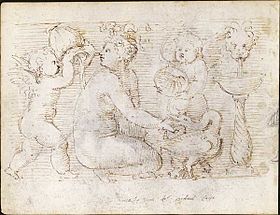Rodolfo Pio da Carpi facts for kids
Quick facts for kids His Eminence Rodolfo Pio da Carpi |
|
|---|---|
| Cardinal-Bishop | |

Portrait by Francesco de' Rossi, c. 1549
|
|
| Diocese | Faenza (1528–1544) Albano (1553) Frascati (1553–1555) Porto (1555–1562) Ostia (1562–1564) |
| Orders | |
| Consecration | 28 December 1532 by Cardinal Bonifacio Ferrero |
| Created Cardinal | 22 December 1536 |
| Personal details | |
| Born | 22 February 1500 Carpi, Duchy of Modena and Reggio |
| Died | 2 May 1564 (aged 64) Rome, Papal States |
| Buried | Santissima Trinità dei Monti |
| Nationality | Italian |
| Parents | Lionello Pio da Carpi Maria Martinengo |
| Alma mater | University of Padua, Ph.D. |
Rodolfo Pio da Carpi (born February 22, 1500 – died May 2, 1564) was an important Italian cardinal. He was also a humanist, which means he studied ancient Greek and Roman culture. He was a supporter of the arts, helping artists and scholars.
Rodolfo came from a family of diplomats, and he became a diplomat himself by age 30. He met powerful leaders like Emperor Charles V and King Francis I of France. He worked for the Pope, trying to make peace between these rulers. His uncle, Alberto Pio da Carpi, was a famous scholar. This background helped shape Rodolfo's own education and interests. He built a large library and took part in the intellectual life of Rome. He also served on the Roman Inquisition, which was a church court.
Contents
Life Story
Family Background
The Pio family of Carpi became important in the 1300s. They were given control of Carpi by the House of Este. In 1518, with help from Pope Leo X, they also gained control of Meldola and Sassuolo. Rodolfo Pio da Carpi later took charge of these lands.
Many family members were military leaders. Others, like Rodolfo, became diplomats. His uncle, Alberto Pio (1475–1531), was an ambassador and a well-known scholar. The family was even given the title of "prince" by Spain.
Early Life and Education
Rodolfo Pio da Carpi was born in Carpi, near Modena. His father was Lionello da Carpi, and his mother was Maria Martinengo. In 1516, he became a knight in the Knights of S. John of Jerusalem.
He studied at the University of Padua, where he earned a Doctor of Philosophy degree. Later, he moved to Rome and began a career in the Church. Pope Clement VII made him a Papal Chamberlain, a high-ranking assistant to the Pope. In 1528, he became the bishop of Faenza. He held a church meeting, called a synod, there in 1533. However, he was often away from Faenza during his 16 years as bishop.
Diplomatic Missions
Rodolfo's first trip as a diplomat to France was in 1530. He returned in 1533 to arrange a meeting between King Francis I and Pope Clement VII. The meeting happened in Marseille. There, the Pope helped arrange the marriage of Henry II and Catherine de' Medici. The Pope also held important talks with King Francis I and Emperor Charles V.
Carpi became the Pope's official representative, called a nuncio, at the court of King Francis I from 1535 to 1537. He worked to achieve peace between King Francis and Emperor Charles V. Emperor Charles V was so pleased that he named Carpi "protector of the Holy Roman Empire."
While in France, some people in Rome spread rumors that Carpi was secretly helping the Emperor. King Francis I heard these rumors but told Carpi he trusted him. The King even asked the Pope to make Carpi a cardinal. Carpi also started talks about holding a general council of the Church to fix problems like heresy and church reform. He left France in July 1537, after already being named a Cardinal.
Becoming a Cardinal
Pope Paul III made Rodolfo Pio da Carpi a cardinal on December 22, 1536. On July 23, 1537, he received his cardinal's ring and his first church title, Santa Pudenziana. He later changed it to Santa Prisca.
In December 1537, Cardinal Carpi was sent as a special envoy to King Francis I of France. He traveled with another cardinal to try and bring King Francis I and Emperor Charles V together for a meeting with Pope Paul III. The meeting happened in Nice in May 1538. Cardinal Carpi, however, was sent back to Rome to manage the city while the Pope was away.
From 1539 to 1542, Carpi served as the Pope's representative in the March of Ancona. This area was in chaos due to wars. Carpi helped restore order. His most important work there was updating the laws that had governed the region since 1357. Pope Paul III approved Carpi's revised laws in 1544.
In 1543, Cardinal Carpi wrote a special report for Emperor Charles V. It was about how to keep control of the Duchy of Milan, which the Emperor had taken from King Francis I. Carpi advised the Emperor never to give it back to France.
As a cardinal, Rodolfo Pio da Carpi was an important member of the Roman Curia, the Pope's administration. He was part of the Roman Inquisition and supported new religious orders like the Capuchins and the Jesuits.
He changed his cardinal's church title several times, moving to San Clemente in 1543 and then to Santa Maria trans Tiberim in 1544.
In 1544, Emperor Charles V offered him the position of Administrator of Agrigentum (Girgenti) in Sicily. This was mainly a financial benefit, and Carpi never actually went there. In the same year, he helped start the Accademia degli Imperfetti in Meldola. This was a club for educated people to encourage learning and culture.
Papal Elections
Cardinal Pio da Carpi took part in the election of the new Pope after Pope Paul III died in November 1549. This election, called a Conclave, lasted a long time, from November 1549 to February 1550. Many cardinals were sick, and one even died.
The French cardinals wanted to prevent Cardinal Reginald Pole from becoming Pope. They supported Cardinal Carpi for a time. Carpi received nine votes in one round, but the French votes soon shifted to other candidates. Finally, on February 7, 1550, Cardinal Giovanni Maria Ciocchi del Monte was elected Pope Julius III.
Pope Julius III later promoted Cardinal Carpi to the See of Frascati in 1553 and then to the See of Porto in 1555.
In 1558, King Philip II of Spain gave the diocese of Agrigento (which Carpi still held) a large annual income. This was likely a reward for Carpi's past help and a hope for his future support.
Cardinal Carpi was a favorite candidate of King Philip II of Spain in the Conclave of 1559, which followed the death of Pope Paul IV. However, the French cardinals strongly opposed him, and he was not chosen.
On May 18, 1562, Cardinal Rodolfo Pio da Carpi was promoted to Bishop of Ostia. This also made him the Dean of the College of Cardinals, the most senior cardinal.
Art and Collections
Cardinal Carpi was famous for his amazing collection of ancient Roman and Greek sculptures and other old artifacts. His collection was one of the most magnificent "museums" in Rome. Scholars and humanists, even those who weren't strict Catholics, visited his palace in Rome to see his Greek and Latin library. His country home, or villa, was built on the site of ancient Roman gardens.
In the 1550s, a Flemish expert named Antoine Morillon studied the Latin writings in the Cardinal's art gallery. These collections helped make Rome a "museum-city." Even after Cardinal Carpi died, artists continued to visit his collections for inspiration.
Some important items from Cardinal Carpi's collection included:
- The bronze bust known as the Capitoline Brutus, which he gave to the City of Rome. It is now in the Capitoline Museums.
- A marble head called the Dying Alexander, which is now in the Uffizi Gallery in Florence. Many copies were made of it.
- Bronze and marble pieces bought from Duke Alfonso II d'Este.
- A very old manuscript (handwritten book) from the 400s of all the works of Virgil, a famous Roman poet. This is now called the Medici Virgil.
Cardinal Carpi also collected paintings by modern artists. These included:
- Madonna of the Divine Love, a painting from the school of Raphael. It is now in the Capodimonte Museum in Naples.
- History of the Madonna of Loreto and Saint Jerome in his study by Lorenzo Lotto.
- Portrait of a Man, now believed to be by Francesco Salviati, located in the Kunsthistorisches Museum in Vienna.
Death
Cardinal Carpi died in Rome on May 2, 1564, at the age of 64. He had been suffering from a painful illness called gout for a long time. In his last months, the pain was so bad he could barely eat, speak, or sleep.
When he died, he left behind a large debt, which Pope Pius IV criticized. He was buried in Rome at Santa Trinità dei Monti, a church above the Spanish Steps. A monument was built there in his memory in 1568.
See also
 In Spanish: Rodolfo Pio para niños
In Spanish: Rodolfo Pio para niños


